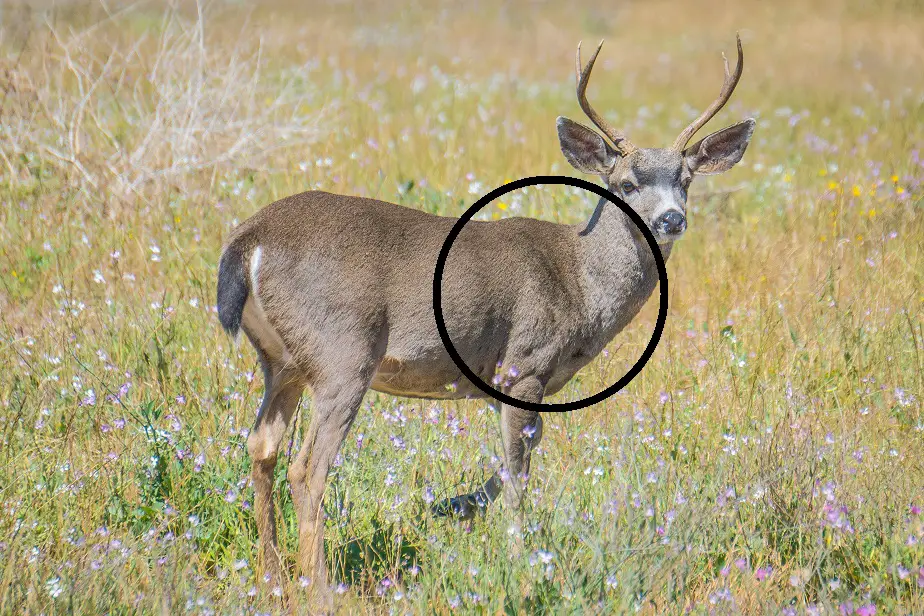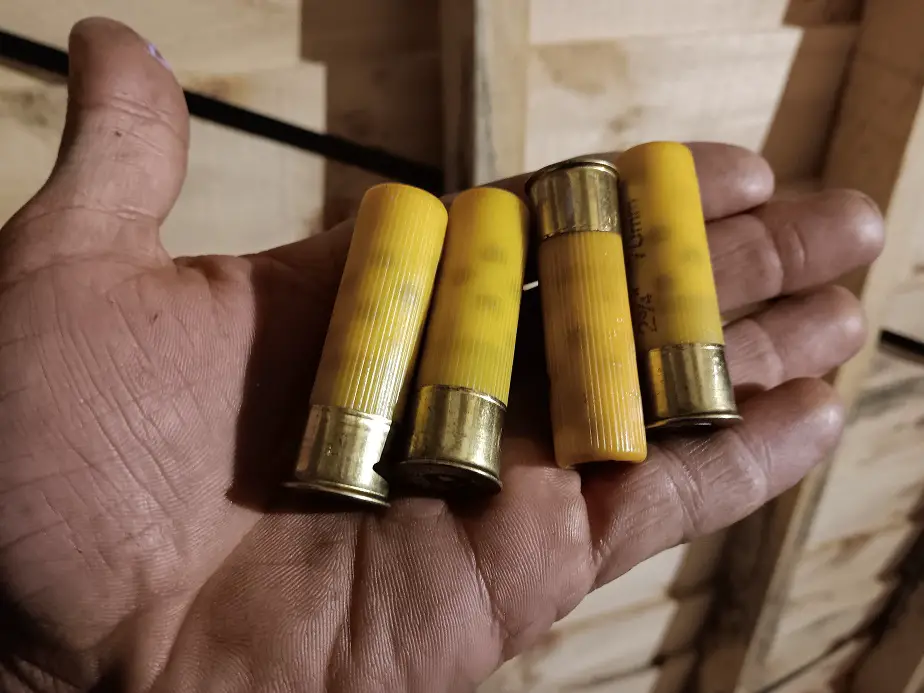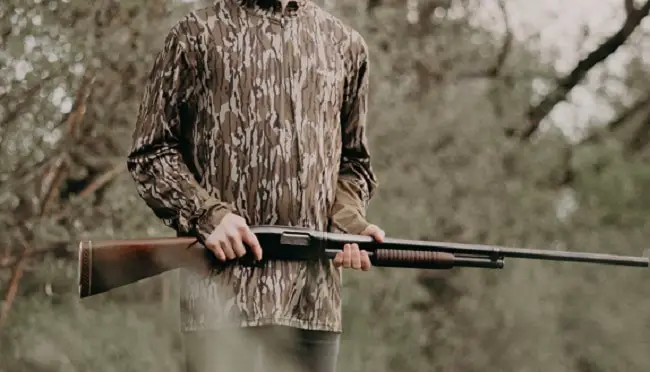Living in southern Michigan where we use shotguns and muzzleloaders for deer, 90 percent of my deer were killed with buckshot. Believe me, it works.
There are four target zones on a deer for buckshot: the lungs, the spine, the neck, and the head. No.4 to No.1 buckshot are best on a more forward target, where a hit to the spinal cord or brain is likely. Larger buckshot can be effective in the traditional target zone.
Where you shoot depends on your buckshot, how tight the pattern is, how much penetration it will get, and how far the deer is. Some brands and lines of ammo are significantly better than others and that affects the pattern a lot as well.

Where to Aim with Buckshot on a Deer
So, the head, the neck, or the lungs, which one is best? I’ve heard heated arguments for all three. The first one I’m going to discuss is the head. The brain of a deer is about the size of one of those little half-sized oranges. It’s not very big. By itself, it’s not an adequate target.
But it’s not by itself. If you fire at the head, half of the pattern will also be covering the spine and neck. The spine and neck are great targets. One pellet that disrupts either the brain or the spine will bring your deer down on the spot. however, I do not recommend firing a load of buckshot at a deer’s head.
There is a very simple reason here. At 30 yards, my shotgun shoots an 18-inch pattern with most buckshot. If I take an 18-inch circle and put it centered on a deer’s head, most of the pattern doesn’t cover anything vital. In fact, most of the pattern doesn’t cover anything at all. you will cover the head and about 5 inches of the neck.
You really want most of your pattern to be on the deer. This brings me to the next target zone, the neck. At any practical hunting distance, and with a tight pattern, you can aim in the middle of the neck and have a much better chance. You will have the entire neck in your pattern, twice the lethal coverage.
Much better than aiming at the head. Still, at least half of your pattern area is missing the animal. Then there is the lung shot. I honestly don’t really like this one either. If it seems like I can’t recommend hunting deer with buckshot, just keep reading.
The lung shot will kill a deer, but it will run. And you will have a horrible time tracking it without much of any blood trail to follow. If you aim at the lungs, you stand a chance of taking out the spine with the top of your pattern, which would be nice.
I actually killed all of my deer this way. I aimed at the lungs, just behind the shoulder. All between 35 and 60 yards. They all had at least one pellet in the spine as well as several in the lungs, so every deer went down on the spot. But they did all require a finishing shot.
That was an important lesson of hunting with buckshot. You really need to hit the spine. It worked, but I think there is a method that will work with a higher degree of certainty. It’s a bit of a hybrid between two methods. I will aim for the front of the shoulder, near the base of the neck.
Now hear me out, aiming for the shoulder takes the pattern, and spreads it out between the heart and lungs, the backbone, and the neck. Pretty much 100 percent of the pattern will be on the deer. There will be about a 3-inch circle in the front of the shoulder that is non-lethal, the shoulder ball joint.
This way, I maximize pellets in the spinal column and still get some in the lungs. Within reasonable distance, the pattern will be tight enough to put several pellets in the pine and the deer will drop right there, you will have some shot in the lungs to finish things off too.
There aren’t many accessories I’d use for shotgun hunting. But, there are two I always have.
- An Allen buttstock shell holder
- and a Hope’s bore snake
Other than a decent cleaning kit, you really don’t need much else.

How Buckshot Works
Buckshot hunters come in two primary categories. There are the penetration guys and the full pattern guys. The penetration guys believe that larger buckshot is more lethal because it penetrates better. The full pattern guys like smaller buckshot so they have more pellets in the target.
The two different theories are quite different, and to be honest, both take deer every year. Many folks think it’s a toss-up. Either one sounds like it would work well enough. But let’s look into it further yet. Which of the two theories is proper?
First, I’m going to do what my logic teacher taught me. Let’s take each premise and take it to the extreme, just to see if the idea, in general, makes sense. We’ll compare the smallest shot size with the largest. Ready for a laugh?
What would best kill a deer, a one-ounce load of number 8 birdshot, or a one-ounce slug? Okay, now that I’ve got you thinking, I will ask why the slug is more lethal. It’s because the slug is heavy enough and powerful enough to penetrate deep and to break heavy bones.
Lots of little holes by themselves do not work better than one big hole. The rule at play here is killing power. Believe it or not, there is a fairly good way to measure the killing power of a bullet. By measuring sectional density. The more sectional density, the better it will retain energy and the deeper it will penetrate.
With spherical shotgun pellets, the only way to increase sectional density is to increase the pellet size. Therefore, bigger pellets will penetrate deeper. You probably already knew that. But why does more penetration of a few outweigh less penetration of many?
Technically, if you combined the penetration of all the pellets in a load of No.4 buckshot and compared it to the combined penetration of 00 buckshot, the No.4 buckshot wins hands down. But that doesn’t really matter. Here’s why.
The individual pellets of No.4 buckshot often don’t go deep enough to reach anything good. Except at under 30 yards, it doesn’t have the power to bust through the hide and penetrate both lungs. It doesn’t have the energy or penetration to break the spine past that point either.
Buckshot is a close-range option. The maximum effective range of buckshot is 50 yards. if you are shooting a good patterning, full power load of 12 gauge 00 or 000 buckshot, 50 yards is about the max.
With No.1 or No.2 Buckshot, it’s more like 35-40 yards max for a potent load that groups tight. If you are shooting No.3 or No.4 buckshot, you should keep it under 30 yards. This is simply figuring for penetration.
Because they are spheres, they have a horrible sectional density. Because they have a poor sectional density, they shed their energy fast, both in the air and in the target.

Common Buckshot Choices for Deer Hunting
Anything under a 20 gauge should not be considered. With a 20-gauge, generally, No.3 buckshot is what you find. It will work, but you better keep shots close. I consider it a 35-40 yard load. The smaller pellets don’t keep up energy as well as what I like. If you go to a 12 gauge, and with larger shot, you can increase the effective range somewhat.
The most common, and arguably the best buckshot for deer is 12-gauge 00 buckshot in a 2 ¾ inch shell. This is generally loaded with nine of the 33 caliber lead balls to go about 1,250 feet per second. You can get more
pellets and more speed in a 3 or 3 ½ inch shell, but most people don’t like them.
Anything bigger puts a serious wallop on your shoulder and the shorter ones seem to work fine. You can always shoot a larger shell if your gun holds them, they are just more expensive and have a serious amount of recoil. There isn’t much out there in 000 buckshot, it’s never really been popular. It never seemed to pattern well.

The Best Buckshot for Deer
Hornady has several 00 buckshot that uses their flitecontrol shot-cup wad. It’s consistently the best grouping buckshot out there. It’s also fairly inexpensive. Hornady has an 8-pellet load that pops out at a smoking 1,600 fps, and groups nearly half that of other common lads.
I wouldn’t have an issue with Hornady’s loads. 6 of my deer were shot with Remington 00 buckshot. Remington has 9 pellets at 1,325 fps. Nothing spectacular, but it worked for m first 6 deer. My last deer was shot with 2w ¾ Winchester 00 buckshot. Winchester 2 ¾ is equal to the 2 ¾ Remington loads. Neither pattern was exceptionally tight.
I have heard some good things about a neat load from the Dixie Slug Company. The Dixie Tri-Ball has 3 60 caliber lead balls in it going about 1,00 fps. I haven’t used them myself, but I have heard several people getting outstanding results (incredibly tight groups) at 50 yards.
Some people have the mistaken idea that buckshot is a great option for “brush bucking”. They claim that it is an appropriate choice for shooting through thick brush at an animal. Don’t do that it’s dangerous and unethical to shoot something you don’t clearly see.
You cannot take a shot that isn’t clear. You need to make sure your bullets hit the target, not a thicket of maple saplings. If you don’t have a clear shot, don’t take it. That’s how animals run off wounded, never to be found.

